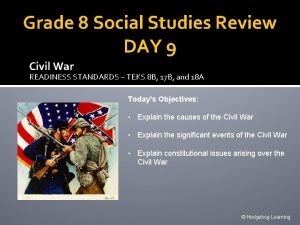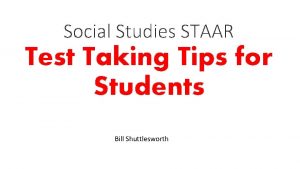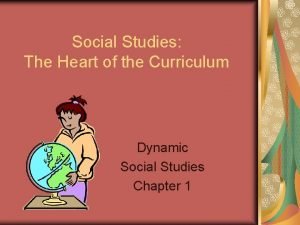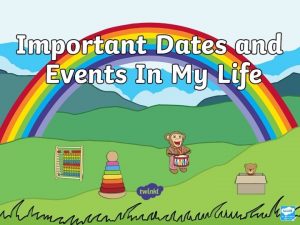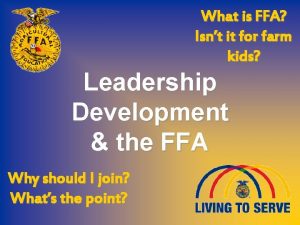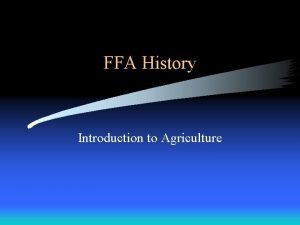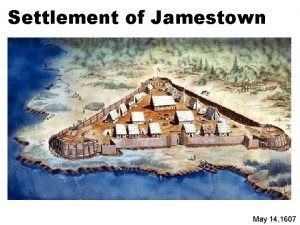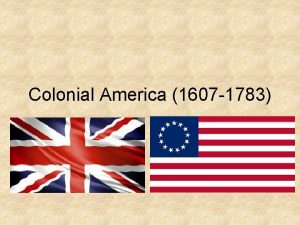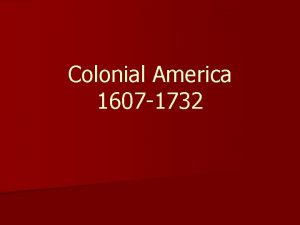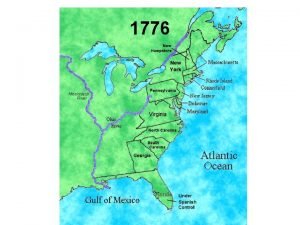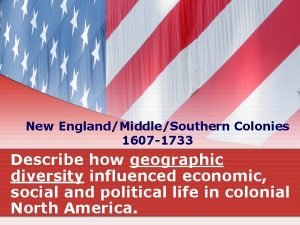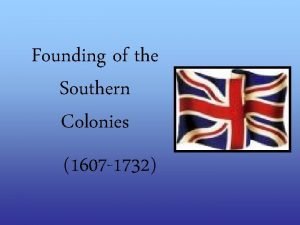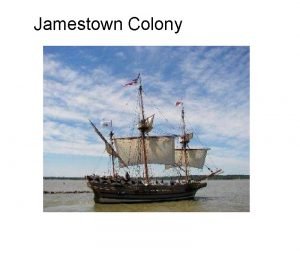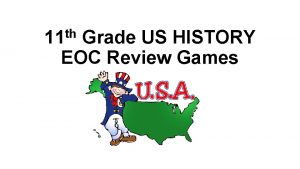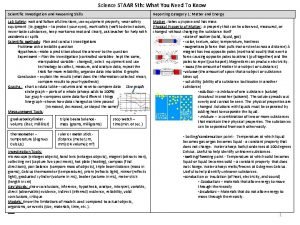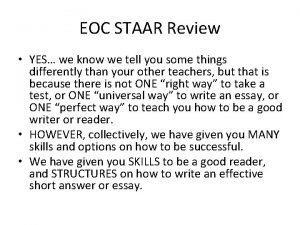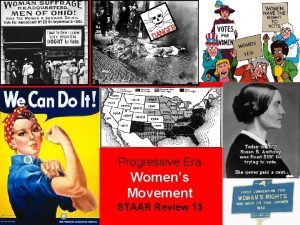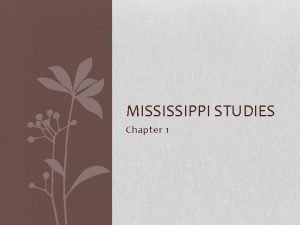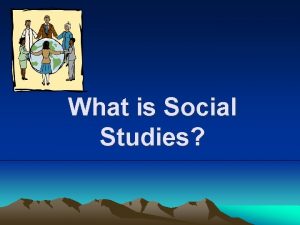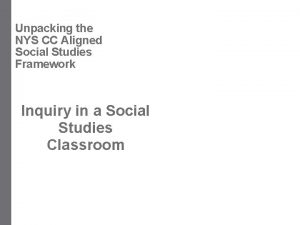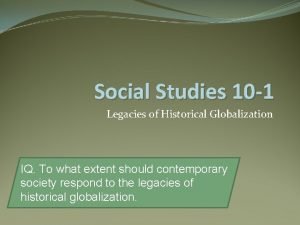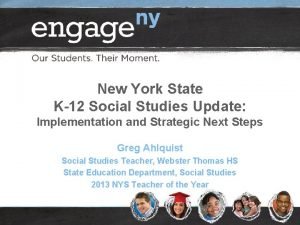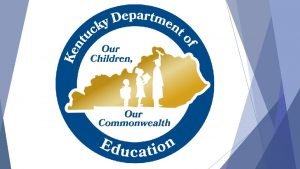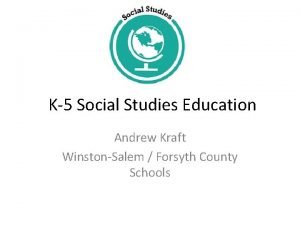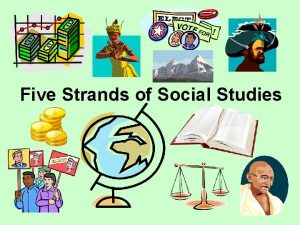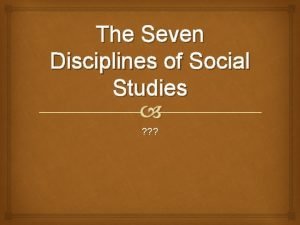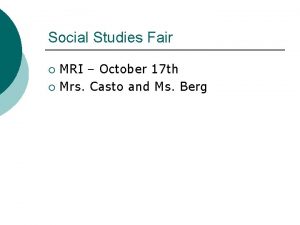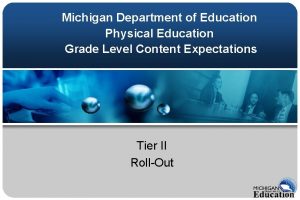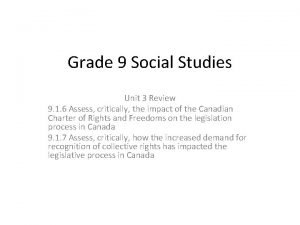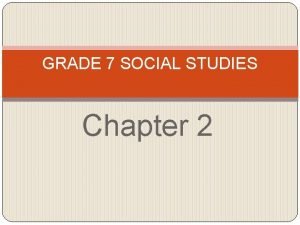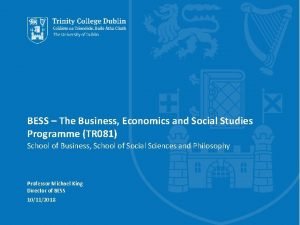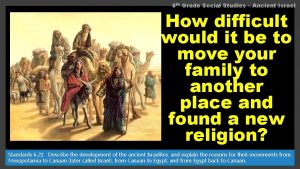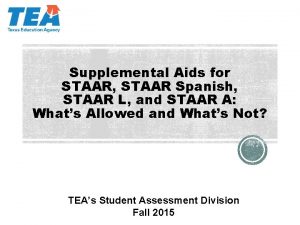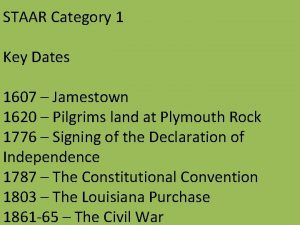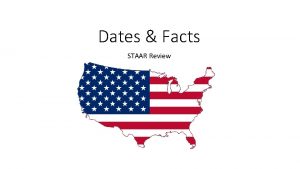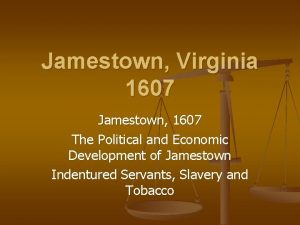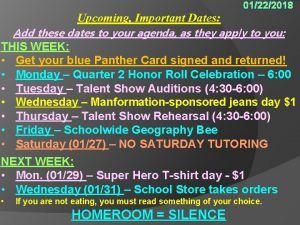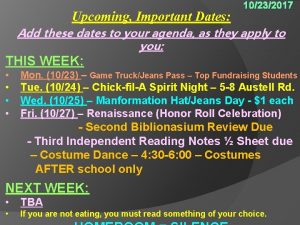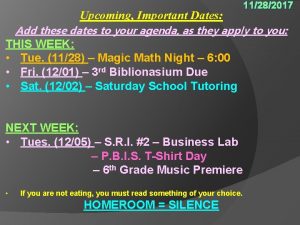Social Studies 8 STAAR Review IMPORTANT DATES 1607



































































- Slides: 67

Social Studies 8 STAAR Review

IMPORTANT DATES • • • 1607 – Jamestown, Virginia 1620 – Mayflower Compact 1776 – Declaration of Independence 1787 – U. S. Constitution 1803 – Louisiana Purchase 1861 -1865 – U. S. Civil War

COLONIAL ERA

Christopher Columbus • “In 1492, Columbus sailed the ocean blue” • Accidentally discovered the Americas while searching for a new route to the East. • As a result of this voyage, a new age of European exploration and conquests of the Americas began!

Jamestown – 1607! The first permanent English settlement in North America, founded by the Virginia Company of England. Capt. John Smith Pocahontas

House of Burgesses - Virginia First representative government in the colonies Dutch ship brings 20 slaves to Jamestown

1620 – The Pilgrims, on the Mayflower, land in Plymouth, Massachusetts The Mayflower Compact is the first form of self-government in the Americas

Puritans land in Massachusetts and start the city of Boston. Massachusetts becomes the 2 nd English colony in North America Famous Events: • Salem Witch Trials • Fundamental Orders of Connecticut (1 st written constitution in the colonies!) • Anne Hutchinson

Maryland is started by Lord Baltimore as a safe place for Catholics Roger Williams starts Rhode Island

Dutch New Netherlands colony becomes the English colony of New York. Pennsylvania is founded by William Penn, a Quakers were a religious group that believed in equal rights for women, religious toleration and non-violence. They were also the first anti-slavery society in America.

Georgia, started by James Oglethorpe as a refuge for debtors, becomes the last of the 13 original colonies.

Mercantilism • The economic system used by European colonial powers, allowed them to have total control over their colonies. • Colonies provide the mother country with raw materials that the mother country can make money from. Raw goods $$$ $$$

People came to America for many different reasons… PULL FACTORS PUSH FACTORS • • Political oppression Religious persecution War Famine (Irish Potato Famine) • Lack of jobs/land • • Religious freedom Political freedom Economic opportunity Abundant land

Between 1607 and 1775, an estimated 690, 000 Europeans and 278, 000 Africans come to live in the colonies.

New England Colonies Massachusetts, New Hampshire, Rhode Island & Connecticut • Made up of small towns that were wellorganized with a church in the center. Religion was primarily Puritan Christianity. • Soil = hard and rocky, long winters • Subsistence farming = just enough to survive • Primary industries = fishing, timber, shipbuilding, whaling and merchant trade

Middle Colonies New York, New Jersey, Pennsylvania & Delaware • More fertile soil than New England, milder winters • Main crops = grains (“Bread Basket”) • Industries = carpentry, iron works • Different groups brought diversity to the middle colonies. Different religions existed.

Southern Colonies Maryland, Virginia, North Carolina & Georgia • Rich, fertile soil leads to commercial farming. • Cash crops = tobacco, rice and indigo • Slaves = necessary (plantations) • Maryland, founded by Lord Baltimore, became a colony where Catholics could settle (Maryland Toleration Act)

REVOLUTION

By 1732, there were 13 flourishing English colonies on the east coast of North America. After a century of “laissez-faire” or letting the colonies “do their own thing”, the British government tried to gain control with disastrous results.

French and Indian War England/Colonists vs. France/Indians • George Washington serves in the British army. • Ben Franklin proposes Albany Plan of Union (“Join or Die”) to unite the colonies, it is rejected. • France finally loses and has to give up all of its land in North America to the British. • Treaty of Paris, gave England all land between the Atlantic Ocean and the Mississippi.

French and Indian War leaves the British with a HUGE debt, so they begin to pass taxes that anger American colonists. • • • Proclamation of 1763 (None shall pass!) Sugar Act Stamp Act Quartering Act Townshend Acts Tea Act

The Boston Massacre • British troops fire on American protesters, killing five (Crispus Attucks = first African American to die for independence). • Sons of Liberty and Paul Revere use the incident as propaganda to anger Americans.

Boston Tea Party Sons of Liberty, led by Sam Adams, dump British tea into the Boston Harbor. As punishment, Britain passes the Intolerable Acts (closed the harbor, prohibited town meetings, took away right to jury, new quartering act, etc. )

“The shot heard ‘round the world. ” 1775: Paul Revere rouses the Minute-men to meet the British at Lexington and Concord, the first battles of the Revolution.

Second Continental Congress Meets in Philadelphia and selects George Washington as the Commander of the Continental Army

“The Olive Branch Petition” • Written by members of the Second Continental Congress • Last attempt at peace between British and the colonists • Rejected by King George III

JULY 4, 1776 – Declaration of Independence! • Written by Jefferson and approved by the Second Continental Congress.

“We hold these truths to be self-evident, that all men are created equal, that they are endowed by their Creator with certain unalienable rights, that among these are Life, Liberty, and the pursuit of Happiness. ” Thomas Jefferson, Declaration of Independence 1776

Battle of Trenton • Washington defeats the Hessians (German mercenaries) at Trenton on Christmas Day • Crossing the Delaware River

Battle of Saratoga Turning Point of the War! American victory that convinces France to join the American cause.

Valley Forge • Winter camp for the Continental Army, joined by Marquis de Lafayette and Baron von Steuben. • Becomes a symbol of the hardships of war.

Battle of Yorktown Final Major Battle of the War! • The Americans and the French win! George Washington Gen. Cornwallis

Cornwallis’ Surrender at Yorktown “The World Turned Upside Down”

Treaty of Paris – 1783! British finally recognize the United States as an independent nation.

Articles of Confederation America’s First “Constitution” An agreement by the states to work together. Most power belongs to the states, forming a very weak central government. Weaknesses • No judiciary • No executive branch (President) • One legislature with little power • Each state has one vote • No power to tax • No power to regulate trade between the states

EARLY REPUBLIC ERA

Successes of the Articles of Confederation • Kept the country united during the Revolution • Negotiated the Treaty of Paris of 1783, ending the war • Passed the Northwest Ordinance, set the rules on how a territory becomes a state, no slaves in the territory, education is a priority

Shays’ Rebellion • Daniel Shays, Revolutionary War veteran and farmer • Occurred in western Massachusetts • Small farmers angered by crushing state debts and taxes go on a riot – 4 get killed • Made people realize that the Articles needed to be improved!

Constitutional Convention 1787! Delegates from the 13 states meet in Philadelphia to rewrite the Articles of Confederation, but instead create a whole new constitution. • Virginia Plan – proposed by larger populated states (representation in Congress based on population). • New Jersey Plan – proposed by less populated states (representation in Congress based on equality). • The southern slave states want their slaves counted for representation purposes, but not for taxation.

Compromises of the Constitutional Convention • Great Compromise – created a House of Representatives based on the population of each state and a Senate with two senators for each state. • Three-Fifths Compromise – every 3 out of 5 slaves would be counted in terms of representation.

1787 The Constitution of the United States is approved by the delegates.

Preamble to the Constitution “We the People of the United States, in order to form a more perfect union, establish justice, insure domestic tranquility, provide for the common defense, promote the general welfare, and secure blessings of liberty to ourselves and our posterity, do ordain and establish this Constitution for the United States of America. ”

7 Principles of the Constitution • Federalism – SHARING is caring! • Popular Sovereignty – the people rule through their vote. • Republicanism – People vote for representatives. • Separation of Powers – Three branches of government. • Checks and Balances – Each branch checks over one another. • Limited Government – Everyone, including powerful leaders, must obey laws. • Individual Rights – Personal freedoms, liberties and privileges are guaranteed by the law.

Yeah! The Constitution is ready for approval! Or is it? FEDERALISTS (J. Adams, A. Hamilton, J. Madison) – supported a stronger federal government, wanted the Constitution ratified without a Bill of Rights. ANTI-FEDERALISTS (G. Mason, A. Burr, P. Henry) – feared a strong central government, wanted stronger states and a Bill of Rights added before they would support it.

Federalist Papers Essays written by the Federalists to convince people that a stronger federal government was needed and to ratify the Constitution without a Bill of Rights. James Madison Alexander Hamilton John Jay

Bill of Rights First 10 Amendments to the Constitution 1 st – Freedom of speech, press, religion, petition and right to assemble 2 nd – Right to own guns 3 rd – No quartering of soldiers 4 th – Protection against unreasonable search and seizure 5 th – Right to due process, right to remain silent, no doublejeopardy 6 th – Right to jury in criminal trial, speedy trial, lawyer 7 th – Right to jury in civil suits 8 th – No cruel and unusual punishments 9 th – These aren’t your only rights 10 th – Powers not given to the national government go to the state governments

Separation of Powers LEGISLATIV EXECUTIVE E Congress President Writes the laws Carries out laws JUDICIAL Supreme Court Interprets the laws

Checks and Balances LEGISLATIV EXECUTIVE E • Controls money • Overrides vetoes • Power of impeachment • Approve appointments • • Veto power Make appointments Power to pardon Issues executive orders JUDICIAL • • Judicial Review Serve for life

Federalism

George Washington 1 st President Main Events: • Whiskey Rebellion • Wars with Indians • Farewell Address – Stay neutral (don’t get involved in other nation’s affairs) – Stay away from political parties

John Adams 2 nd President Main Events: • XYZ Affair • Alien and Sedition Acts • Jefferson and Madison respond with the Virginia and Kentucky Resolutions, introduce states’ rights. Thomas Jefferson 3 rd President and Main Author of the Declaration of Independence Main Events: • Louisiana Purchase (1803!) • Marbury v. Madison establishes Judicial Review • Lewis and Clark Expedition • Embargo Act

James Madison 4 th President and Father of the Constitution Main Events: • War of 1812 vs. Great Britain • Star Spangled Banner, written by Francis Scott Key • Battle of New Orleans makes Andrew Jackson a war hero • Stoppage of manufactured imports leads to Industrial Revolution James Monroe 5 h President Main Events: • Era of Good Feelings • Adams-Onis Treaty (U. S. gets Florida) • Missouri Compromise of 1820 • The American System • Monroe Doctrine (warning to European nations)

• War hero from War of 1812 (Battle of New Orleans) • First President from the deep South • Created the modern Democratic Party • Introduced Jacksonian Democracy (increased voting to more citizens) • Represented the common man • Jackson vs. Bank of the U. S. – vetoed charter for the Bank of the U. S. to continue operating • Jackson vs. Native Americans – Indian Removal Act passed, ignored Worcester v. Georgia ruling, led to the Trail of Tears • Jackson vs. John C. Calhoun – Nullification Crisis Andrew Jackson 7 th President

“The Big Three” • John C. Calhoun: Former Vice President and Senator from S. Carolina; became the voice for the South regarding issues such as states’ rights and slavery; Jackson’s political enemy during the Nullification Crisis. • Henry Clay: Known as the “Great Compromiser”; wrote the Missouri Compromise, the American System, Compromise of 1833 and the Compromise of 1850. • Daniel Webster: Firmly against secession by any state, supported industrial economy and became Calhoun’s political enemy.

The Industrial Revolution

Era of Reform

Steps to the Civil War 1. 2. 3. 4. Declaration of Independence Constitutional Convention (3/5 Compromise) Missouri Compromise Difference in economies and growth of Northern cities and industry 5. Tariff of Abominations 6. Nullification Crisis 7. Wilmot Proviso

Steps to the Civil War 8. Compromise of 1850 9. Fugitive Slave Act 10. Uncle Tom’s Cabin 11. Kansas-Nebraska Act 12. Dred Scott v. Sanford 13. John Brown’s Attack on Harpers Ferry 14. Election of Lincoln as President in 1860

THE CIVIL WAR 1861 -1865

Civil War (1861 -1865) • 1861: Southern states secede and form the Confederate States of America. They elect Jefferson Davis as their President. • President Lincoln called for 75, 000 men to “put down the insurrection”.

Confederate forces fire on Fort Sumter in Charleston, South Carolina. The Civil War begins!

Famous Civil War Generals CONFEDERACY Robert E. Lee “Stonewall” Jackson UNION Ulysses S. Grant William T. S herman

Important Civil War Battles • Fort Sumter – 1 st battle of the Civil War • Battle of Antietam – Single bloodiest day in the war (23, 000 casualties combined) • Siege of Vicksburg – Union forces led by Grant capture Vicksburg, Mississippi, giving the North control of the Mississippi River • Battle of Gettysburg – Robert E. Lee’s army invades the north and meets Union forces in Gettysburg, PA. Lee’s forces lose, making the battle the turning point of the Civil War.

The Emancipation Proclamation Issued by Abraham Lincoln in 1863 This proclamation announced that all slaves in the rebelling states were to be free. Yet, because the war was still being fought, not a single slave was freed. Still, many slaves knew about the Proclamation and began to do their part to see that the Confederacy was defeated.

Gettysburg Address President Lincoln gives a speech to dedicate a cemetery to the men who died and to encourage Americans to finish the war. “Four score and seven years ago our fathers brought forth, on this continent, a new nation, conceived in Liberty, and dedicated to the proposition that all men are created equal. ”

Civil War is Over! General Robert E. Lee surrenders to Ulysses S. Grant at Appomattox Court House, Virginia. Lincoln is assassinated in a theater shortly after by John Wilkes Booth.

Reconstruction Amendments • 13 th – Ended slavery in the U. S. • 14 th – Gave citizenship and due process to anyone born in the U. S. • 15 th – Gave black men the right to vote • 19 th – Women have the right to vote
 Day 10 grade 8 social studies staar review
Day 10 grade 8 social studies staar review Staar
Staar Importance of social science
Importance of social science What is social studies and why is it important
What is social studies and why is it important Important dates in italy
Important dates in italy Important dates in my life
Important dates in my life Important dates for harriet tubman
Important dates for harriet tubman Father of forensic toxicology
Father of forensic toxicology Important dates in ffa history
Important dates in ffa history Important dates in ffa history
Important dates in ffa history Expansion of the united states of america 1607 to 1853 map
Expansion of the united states of america 1607 to 1853 map Số la mã
Số la mã May 14 1607
May 14 1607 1783-1607
1783-1607 1732-1607
1732-1607 1776-1607
1776-1607 1491 to 1607 timeline
1491 to 1607 timeline 1733-1607
1733-1607 Carolina charter of 1663
Carolina charter of 1663 1607 king of england
1607 king of england Wingapoo
Wingapoo 11 grade us history eoc review
11 grade us history eoc review Progressive era kahoot
Progressive era kahoot 8th grade science staar review reporting category 4
8th grade science staar review reporting category 4 8th science staar review
8th science staar review Science staar review
Science staar review English 1 staar review
English 1 staar review Biology staar review
Biology staar review Biology staar review
Biology staar review Staar review
Staar review Paradigm shift from women studies to gender studies
Paradigm shift from women studies to gender studies Example of a news story
Example of a news story From most important to least important in writing
From most important to least important in writing Least important to most important
Least important to most important Social thinking and social influence
Social thinking and social influence Social thinking social influence social relations
Social thinking social influence social relations 4th grade va studies sol
4th grade va studies sol Ms studies chapter 1
Ms studies chapter 1 Social studies alphabet
Social studies alphabet What is living together in social studies
What is living together in social studies What is rights in social studies
What is rights in social studies Iowa social studies standards unpacked
Iowa social studies standards unpacked History grade 9 unit 5
History grade 9 unit 5 Renaissance definition social studies
Renaissance definition social studies Social studies notebook cover
Social studies notebook cover What is scale in social studies
What is scale in social studies Grand exchange social
Grand exchange social Social studies as citizenship transmission
Social studies as citizenship transmission Pegs chart social studies
Pegs chart social studies Worldviews textbook
Worldviews textbook Engage ny.org
Engage ny.org Kas standards
Kas standards Winston salem forsyth county schools social studies
Winston salem forsyth county schools social studies Brain wrinkles social studies
Brain wrinkles social studies What are the 5 strands of social studies
What are the 5 strands of social studies Social studies essay
Social studies essay Affirmation of identity social studies definition
Affirmation of identity social studies definition Disciplines of social studies
Disciplines of social studies Social studies terminology
Social studies terminology Wvssfair
Wvssfair Social studies do now questions
Social studies do now questions Understanding of ideologies social 30-2
Understanding of ideologies social 30-2 Glce social studies
Glce social studies Social 9 chapter 3 test
Social 9 chapter 3 test Chapter 2 social studies grade 7
Chapter 2 social studies grade 7 Business economics and social studies
Business economics and social studies Nsms 6th grade social studies
Nsms 6th grade social studies Nycdoe social studies scope and sequence
Nycdoe social studies scope and sequence
